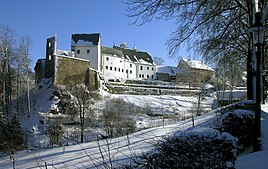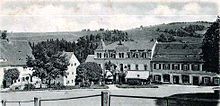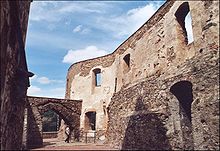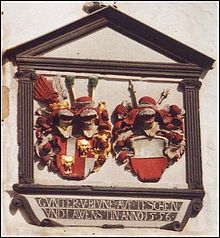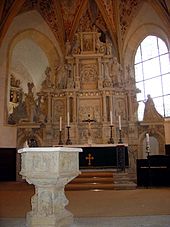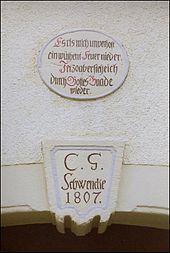Lauenstein (Altenberg)
|
Lauenstein
City of Altenberg
Coordinates: 50 ° 46 ′ 57 ″ N , 13 ° 49 ′ 32 ″ E
|
||
|---|---|---|
| Height : | 518 (470-710) m above sea level NHN | |
| Residents : | 517 (Dec. 31, 2018) | |
| Incorporation : | March 1, 1994 | |
| Incorporated according to: | Bear stone | |
| Postal code : | 01778 | |
| Area code : | 035054 | |
|
Location of Lauenstein in Saxony |
||
|
Lauenstein Castle
|
||
Lauenstein is a place in the upper Müglitztal , which is now a district of the city of Altenberg . It is one of the oldest settlements in the foundations Osterzgebirge and received in 1494 the town charter . In 1994 Lauenstein merged with Bärenstein under the name Bärenstein and in 1996 it was reclassified to Geising , with which it was incorporated into Altenberg in 2011.
geography
Geographical location
Lauenstein is located about 40 km south of Dresden in the Eastern Ore Mountains in the upper valley of the Müglitz . The place extends from the train station at an altitude of 470 m on the left slopes of the Müglitz up to 710 m high above the river. The center is located on a terrace about 50 m above the Müglitztal.
geology
The underground rocks in the Lauenstein area are assigned to the Freiberg gray gneiss . This rock was formed in the course of the uplifting of the Ore Mountains during the transformation of older sediments under high pressure. In the last phase of the mountain formation , metal-containing solutions and vapors rose in the Upper Carboniferous , which penetrated the earth's crust and formed ore deposits .
Natural space
The area around Lauenstein is part of the Eastern Ore Mountains, an up to 905 m high, eroded hull landscape with little pronounced elevations. The only exception is the 824 m high basalt chimney of the Geisingberg about four kilometers southwest of Lauenstein. The heights decrease evenly towards the north. The region gets its mountainous character and structure from deeply cut river valleys , especially that of the Müglitz. The Lauensteiner climate is determined by annual mean temperatures around 6 ° C and annual precipitation around 870 mm, of which around 25% is snow. Since the mountain ranges all around tower over the city by around 80 m, it is protected from the sometimes harsh Erzgebirge climate. The gneiss soils, which predominantly weather into brown podsols, enable arable use ( vegetation period around 200 days), which, however, is concentrated on grassland management due to the climate and the low yield of the soils . The spruce, fir and beech mixed forest that originally dominated the area has largely fallen victim to agriculture, settlement and mining. In the past, the poverty of forests in the ridge areas in the Eastern Ore Mountains was partly responsible for repeated and sometimes devastating floods, from which the Müglitztal in general and the parts of Lauenstein in particular were particularly affected in 1927 and 2002 .
story
founding
The settlement goes back to a border castle built in the 12th century , which was first mentioned in 1289 as "castrum Levensteyn". As early as 1241, however, a "Christianus de Lewensteine", son of Boriwo de Tarant , administrator of the Tharandt castle in Marche , was mentioned. The place Lauenstein emerged as a suburbium under the protection of the castle. It was first attested in 1340 as "hous with the stetychein".
Coat of arms and name
The blue coat of arms of the former city depicts a golden lion climbing a silver rock face. The motif of the rock climbing lion was first used on a seal from 1683. It refers to the city name. The origin of the name Lauenstein is unclear. BRANDNER (1845) traced it back to lions , which he believed to be found in the jungle of the Ore Mountains. Further interpretations refer to a derivation of the name Leonhard, refer to the sheltered location ( the laue stein ) or construct a derivation from the English words low and stone (description of the location of the castle rock). It seems more realistic, however, that the lords of the castle chose the heraldic animal because it enjoyed great popularity as a shield animal for knights after the crusades . It is possible that there was also a connection to the lions appearing in the margravial-Meissnian or in the Bohemian coat of arms. The spelling of the name of the castle and town has changed several times in the course of history. What has come down to us are, among others. the spellings "castrum Levenstyn" (before 1289), "Lewenstein" (1320), "Leuwenstein" (1372), "Lauwensteyn" (1386), "Lawenstein" (1389), "Lauwinsteyn" (1412), "Lawenstein" ( 1485) and "Laustein" (1515). The current spelling appeared for the first time as early as 1410, but did not gain acceptance until 1800.
Development of the castle and chateau
There is uncertainty in historiography about the founding of Lauenstein Castle, which preceded the urban development, probably around 1200. A number of authors (Schmidt 1927; Hammermüller 1964; Blaschke 1966) ascribe the castle grounds to the Margraves of Meissen , while Adam (1994) sees Bohemian nobles as the founding fathers. If the first case is true, then the facility probably served to protect the ore deposits discovered near Freiberg and Dippoldiswalde at the end of the 12th century . If, on the other hand, the establishment was initiated by the Bohemian Hrabischitzer family , Lauenstein was more likely an outpost of the castles in Graupen and Kulm .
What is certain is that the castle was owned by the Marquis of Meissen at the time it was first mentioned (1289 as "castrum Levensteyn"). It was built in an early phase of the development of the upper Osterzgebirge on a steep mountain spur above the Müglitztal as a border castle. Since it was only accessible from the narrow mountain side, it could be secured and protected particularly effectively. The castle was the starting point and base of the knightly peasant colonization . The villages Liebenau , Löwenhain , Fürstenau and Fürstenwalde emerged from this colonization . Lauenstein Castle protected these settlements and the paths of the Kulmer Steige to Bohemia to the east of it and at the same time secured the claims to power and ownership of the Margraves of Meißen on the border forest, which is rich in natural resources.
When it was built, the complex probably only had a comparatively simple design (triangular core castle without a keep with a gate tower). Since Lauenstein is mentioned as a castle as early as 1340 , it can be assumed that the building will expand rapidly and that it will develop into a typically medieval castle. Only remnants of the actual castle are preserved today, however, as the complex burned down after a devastating city fire on May 2, 1594 and a Renaissance building was built as a residential palace in its place until the 17th century . A number of rooms richly furnished with sculptor , stucco and painting work, which make the castle still worth seeing today, took place. Until the mid-19th century castle and city Lauenstein were also centers of the vast same basic rule that except for the Erzgebirgskamm close in the 15th century Zinnwald enough. In 1835 this rule covered an area of 94 km² with the city of Neugeising , 15 villages or smaller settlements, including Börnersdorf , Breitenau , Fürstenau, Fürstenwalde, Hennersbach , Liebenau, Löwenhain, Oelsengrund and Zinnwald with a total of 5,219 residents.
The Lauensteiner castle and landlord had numerous rights and privileges vis-à-vis these subjects, including the mountain shelf for low metals, inland fishing in all streams and rivers, the compulsory meal in the mills of the manor , the payment of loan money for changes of property, inheritance interest, property tax and the lower and high jurisdiction . The latter also included sentences to death, carried out e.g. B. December 21, 1602: ... December 21. At Launstein auf dem Marckte, the former mayor Phillipp Schelle and Stephan Richter's wife were beheaded for adultery, but Thomas Schmatzen's wife, who was also kept shut, was expelled. Between 1607 and 1730 six death sentences were passed on the market square in front of the castle. Enforced for adultery , infanticide and murder . The economic significance of the manorial privileges is made clear by the following figures: In the first half of the 19th century, the manor was able to earn 1,371 thalers in monetary interest, 161 bushels of interest grain, 715 bushels of interest oats, 410 chickens and geese, over 2,500 eggs and over 2,300 days with service obligations (field work, harvest, craft services) for themselves. From the middle of the 19th century, the landlord's demands gradually fell out of use. Some of them were replaced by new laws, which replaced benefits in kind with cash rents. With the shelf mining law of 1851, the Lauenstein lordship lost the lower mountain shelf and the vassal mining office, which had its seat in Neugeising and whose territory included the rich tin ore deposits on the Zinnwald, which had been developed since the 16th century, was dissolved. After the end of the Second World War, the then landlords of Hohenthal-Püchau were expropriated as part of the land reform . From 1943 onwards, large parts of the most valuable manuscripts from the Hamburg State and University Library were stored in the palace , which were then confiscated by the Red Army in 1946. Sudeten German expellees were also temporarily accommodated in the castle and its outbuildings . Since 1980 the facility has been used as a museum (today the Osterzgebirgsmuseum ).
The castle and the town church of Lauenstein are selected sites of the UNESCO World Heritage Ore Mountains Mining Region .
In the context of centuries of history, inter alia the following owners about Lauenstein castle and lordship (incomplete):
- 1320: Albert the Elder, Burgrave in Leisnig pledges Lauenstein Castle to Margrave Friedrich I (Meißen) .
- 1340: Burgraves of Bergau
- 1372: Lauenstein becomes a Bohemian fiefdom (until 1459).
- 1374–1436: The von Kürbitz family resides as a vassal of the von Bergau on Lauenstein.
- 1436: Elector Friedrich II enfeoffs Nikolaus, Hans and Günther von Planitz with Lauenstein.
- 1449: Elector Friedrich II. Acquires Lauenstein in order to get a share in the emerging tin mining of Altenberg . He has Lauenstein administered by Vögten. One of the first administrators was Kaspar von Schönberg auf Rechenberg.
- 1462: electoral office under Franz von Körbitz
- 1464: Elector Friedrich II. Sells Lauenstein to Hans Münzer , a wealthy mine owner and councilor from Freiberg . The purchase price was 700 shock groschen . Münzer was significantly involved in the mining development of the Lauenstein region. The first tin discoveries and the beginning of tin mining in and around Lauenstein probably took place in the time of his manorial rule . His son Erhard sold Lauenstein in 1490.
- 1490: Stephan Alnpeck the Younger, Governor of Freiberg, acquires Lauenstein. It gives the place urban privileges.
- 1497 (according to other sources 1505): Friedrich von Saalhausen
- 1517: The von Bünau family (related to the von Saalhausen family ) acquires Lauenstein. The Bünaus were a widespread Saxon noble family who were represented in Germany and Bohemia with 15 main tribes and 28 subsidiary lines. For the region of the Eastern Ore Mountains they exerted a decisive influence on the cultural and economic development. They were inter alia also lords and lords of Weesenstein and Kuckuckstein Castle in Liebstadt . In 1821 the family was forced to sell the Lauenstein estate due to the economic decline as a result of the Seven Years' War , the War of the Bavarian Succession and the Napoleonic Wars of Liberation .
- 1821: Lauenstein comes into the possession of Carl Ludwig August Graf von Hohenthal at Dölkau Castle for a price of 175,000 Reichstalers .
- 1826: After only five years, the von Hohenthal family took over the grounds and property at Schloss Püchau . The von Hohenthals remained the castle owners until the expropriation in 1945.
Development of the city
The Lauenstein settlement was created as a suburbium under the protection of the castle of the same name . She was the center and market - the same name and Gewerbeort basic rule that except for the Erzgebirgskamm extended and in the 15th century included the city Neugeising and six surrounding villages. Lauenstein was first mentioned as a settlement in 1340. The foundation seems to have taken place in the 13th century, as the document from 1340 already mentioned a church and three iron hammers . The granting of city rights took place gradually and began in 1374 with market justice (the right to hold a weekly market). In 1489 the residents were allowed to elect a council and mayor , Lauenstein only received full town charter in 1494. The town's economic basis, the center of which was a steeply sloping market square with town houses, protected by a town wall with three gates, was the town's rights and the town's handicrafts based on it , agriculture , which was mainly sideline, and mining, which began around 1450 . The latter led to a modest prosperity, also because the Lauenstein rule encompassed more than just the city area and within its boundaries were parts of the rich tin deposits around Altenberg-Geising-Zinnwald.
The city did not experience any fundamental qualitative changes until the 19th century. The built-up area barely grew, regardless of the effects of the war, the number of inhabitants also remained comparatively constant at a low level. Little development impulses only started after the expansion of the traffic routes (Müglitztalstraße 1857, Müglitztalbahn 1890). The dense urban network in the surrounding area (Altenberg, Geising, Bärenstein, Glashütte, Liebstadt), the natural conditions, the slightly remote location and the largely lack of its own extensive industry prevented any noteworthy urban development . So Lauenstein remained a modest castle and mountain town , which was able to retain much of its original character with the narrow, steep streets and old town houses and which is precisely why it exerts an urban and tourist attraction. However, this potential is increasingly being called into question by the shrinking population and the associated vacancy rates. Lauenstein has had a decreasing population for more than 50 years. Since 1997 alone, the place has lost more than a quarter of its residents.
Cityscape
Lauenstein presents itself due to its small size, a little over 600 inhabitants (2006) live in the village, as a structurally compact complex. However, the buildings in the valley, to which a.o. The district court established in 1902 (now a school), the Müglitztalbahn station, which was opened in 1938, some residential buildings and some of the buildings that were built by the Spinner company in recent years are differentiated from the city center.
Structural structure and buildings worth seeing
The development connects with the market square directly to the castle. Due to the lack of industrialization and the fact that it was largely spared from other catastrophes, Lauenstein remained in its building stock for centuries, so that the structure of the old medieval mountain town was largely preserved. Significant structural extensions were only realized at the end of the 19th century near the train station and along Talstrasse. The town center is characterized by a harmonious cohesion of small town houses used by craftsmen and traders. In the Vorstädtel in front of the former western city wall, the larger houses of the arable citizens still stand . Overall, the Lauensteiner houses are largely structural mixtures of half-timbered , gable wood or slate fittings and stone ground floors with door and gate arches made of sandstone. The townscape is determined by the old castle ruins with the castle and the church.
- Renaissance castle (16th / 17th century): richly decorated portals, castle chapel with late Gothic tracery windows and valuable portrait sculptures as well as a renaissance pulpit from the Meißner Nikolaikirche , splendid interior rooms (coat of arms hall, bird hall) with ceiling and wall paintings and stucco ceilings that are well worth seeing
- Church of St. Marien and Laurentin (1596 - 1602): built by Günther von Bünau as a late Gothic three- bay hall church with a massive tower after the town fire of 1594 , important and unique sandstone work of Mannerism : three-story sandstone altar (1594-1602) by Michael Schwenke with life-size figures that of Bünaus (added in 1615 by Lorenz Hörnig ), the Bünau chapel (hereditary burial site of the Bünau ruling family, around 1600) with rich stucco cover and nine meters high family epitaph of the von Bünaus decorated with alabaster , agate and jasper
- Falconer's fountain: built in 1912
Incorporations
- 1976: Lauenstein became a member of the Altenberg community association
- March 1, 1994: Lauenstein merged with Bärenstein under the name Bärenstein
- August 1, 1996: Lauenstein was reclassified to Geising
- January 1, 2011: With the incorporation of Geising, Lauenstein became a district of Altenberg
Population and size development
The urban development of Lauenstein, which has been modest over the centuries, is clearly reflected in the population development. The number of residents was around 300 to 600 by the middle of the 19th century. Times of war such as 1813 were clearly evident in the statistics due to comparatively high population losses. The development impulses caused by the construction of the Müglitztalstrasse and the Müglitztalbahn caused the population to rise to around 900 in the last quarter of the 19th century. Lauenstein, like other places in the area, had the largest population after the end of the Second World War. At that time the city had almost 1,300 residents, the increase being due to the influx of displaced people from the former eastern regions . The population has been falling continuously for 60 years. By 2006, it had more than halved from its peak in 1946. The causes of this development are mainly to be seen in the low birth rate and the emigration of young people due to work and training places.
Population and size development:
|
Until 1800
|
1801 to 1900
|
1901 to 2000
|
Since 2001
|
Compilation based on Bachmann 1930, Bechter 2000, Blaschke 2003, Büttner 1902, Hammermüller 1964, Sächsische Zeitung local edition Dippoldiswalde of January 16, 2006, Schiffner 1840
(1): estimated based on house numbers from the 16th century, cf. Blaschke 2003
(2) : calculated according to tax lists, see BLASCHKE 2003
(3): residents older than 10 years
(4): according to other sources 325 or 360 residents
(5): approx. 9,000 residents in the district of the royal. District court Lauenstein
(6): from 1997 information at the beginning of the year
Town twinning
Lauenstein maintains a partnership with the district of the same name in the municipality of Salzhemmendorf near Hameln in Lower Saxony . Lauenstein in Lower Saxony also had a castle (now in ruins), which was first documented in 1247 as "Castrum Levenstein".
Economy and Infrastructure
Development of the economy
Lauenstein's economic life was shaped by urban trade and handicrafts , agriculture and mining until the 18th century .
The basis of the urban trade were the urban rights acquired over time, of which the market rights , the beer brewing privilege, the right to hold bread and meat banks and the right to sole sale of salt within the entire manor were the most important. Craftsmen and small traders settled in Lauenstein, who satisfied the needs of the castle, the city and the manor with their products. Economic relations with cities and communities beyond the boundaries of the manorial system already existed at an early stage. For example, the Lauensteiner butchers delivered to Dresden as early as the 15th century .
Mining represented the city's second, rapidly developing economic pillar. It can be assumed that the prospect of mining profits, in addition to the intention to secure the border, already played a role in the construction of Lauenstein Castle, since after the silver finds near Freiberg ( 1168) and the start of tin mining in Krupka (Graupen) (1241) a competition between the Bohemian kings and the margraves of Meissen for the development of the Eastern Ore Mountains began. As early as 1340, reports mentioned three iron hammers in the Lauensteiner corridor. In 1590, the chronicler Petrus Albinus, in his Meißnerische Bergk Chronik , counted the Lauenstein iron alongside that of Berggießhübel and Glashütte among the best in Germany. Albinus was probably not referring to iron ore that was mined in Lauenstein itself, but to ores that, among other things, in the Bad Gottleuba - Berggießhübel area and transported to Lauenstein for processing because of the abundance of wood and the water power of the Müglitz. At that time, tin mining had long since spread to the region. Graupener miners probably started mining for tin soaps as early as 1450 . According to other sources, the first tin was found in 1487 at the location of the town hall (today the Gasthof am Markt). Hans Münzer, who acquired Lauenstein Castle in 1464, had the lower mountain shelf for the tin yield transferred to him by the Saxon Elector and in 1475 set up a vassal mining office for the Lauenstein rule in Neugeising . The ore deposits of Zinnwald formed the spatial focus of mining, while mining also took place in Geisinggrund, on Hirschberg and Hutberg near Löwenhain and on Zeidelweide near Fürstenau. In 1732 there were reports of six tunnels and mines on Lauensteiner Flur and of over 120 miners living in the city. Four years later, on September 13, 1736, around 400 miners took part in one of the largest mountain elevators in the Eastern Ore Mountains in Lauenstein . As late as 1780, a chronicler reported: “The Lauenstein lordship belongs to the Adliche Bünau family and has good tin mines.” At the beginning of the 19th century, however, mining came to a standstill due to the exhaustion of the deposits and the consequences of the last wars (Seven Years War, Liberation Wars) . Attempts to revive the area in the middle of the 19th century were largely unsuccessful, with the exception of the Zinnwald mining industry. With the decline of mining in the 19th century, straw weaving developed into the most important part-time occupation.
Agriculture on the arable gneiss soils represented the third pillar of economic development. However, low arable values (around 25) and the unfavorable or imponderable climatic character did not allow the development of a high-performance economy. Due to the lack of certainty in the calculation of the yields, agriculture was largely an additional acquisition to urban trade and mining until the middle of the 20th century. Of the 5,219 residents of the Lauenstein estate, counted in 1835, only 300 were farmers. Another indication of the minor importance of agriculture was the small field sizes. Before the land reform (1945), two out of three farms on the Lauensteiner Flur farmed less than 2 hectares of land. The operational focus was on livestock and land farming, with hay and oat deliveries from the Lauenstein area up until the Second World War to the Elbe Valley and Dresden. After 1945, agriculture was fundamentally reorganized and modernized by merging the small businesses within the framework of LPG education. The LPG Vorwärts was established in the Lauenstein area with its headquarters in neighboring Bärenstein. This farm, which cultivated around 200 hectares in the 1970s, concentrated on pasture farming, i. H. the use of grassland for milk and beef production.
The traffic-related development of the city and its surroundings at the end of the 19th century laid the foundation for a modest industrialization. In the 1880s, the first factory was the Kühnelt & Cie toy factory, employing 100 workers, 50 of whom were working from home. Starting with watch production in Glashütte, small precision mechanical production facilities were also established in 1918. Ultimately, the opening of the Müglitztalbahn from 1890 onwards contributed to the development of tourism, although this lagged significantly behind the developments in the neighboring towns, in particular Geising and Altenberg. In the 1970s, Lauenstein hosted around 6,000 holidaymakers a year, while Altenberg hosted 16,000.
Today Lauenstein's economy is characterized by typical small-town trades and tourism. Most of the residents commute to work in the surrounding areas or in the upper Elbe valley. With the company SPINNER Lauenstein GmbH, the city also has a medium-sized company in the manufacturing industry (approx. 90 employees (as of June 2017)).
Established businesses
- Spinner Lauenstein GmbH (approx. 115 employees (as of March 2016), production of HF cables for setting up mobile radio transmission and reception systems)
Transport development
The area around Lauenstein was opened up into the 19th century by high roads that connected the Dresden Elbe valley with Bohemia via the Osterzgebirg ridge. Immediately northeast of Lauenstein one of these routes ran from Lockwitz via Glashütte , Dittersdorf , Liebenau to Fürstenwalde. From there the descent took place over the Graupener or Geiersberger Pass to Northern Bohemia. A path led through Lauenstein from Bärenstein to Graupen (Krupka) , which is still marked on old measuring table sheets as the Gaupen path. It was particularly important in the 16th and 17th centuries as a connection route to the Bünau rulers in northern Bohemia ( Jílové u Děčína , Blansko , Děčín , Libouchec ).
With the increasing development of the valley areas as a consequence and prerequisite of the commercial development, the importance of the old mountain trails decreased drastically in the 19th century. The Müglitztal was opened up from 1847 by a valley road that reached Lauenstein in 1857. As state road S 178, it now forms an important connection between the economic center of the Dresden conurbation and the tourist area around Altenberg in the upper Eastern Ore Mountains. Another connection runs as the S 174 from Lauenstein via Liebenau, Breitenau, Bad Gottleuba , Berggießhübel and Rottwerndorf to Pirna . This road was completely redrawn between 2002 and 2004 in the Lauenstein – Liebenau section for the construction of the Müglitztal retention basin .
With the construction of the Müglitztalbahn in 1890, Lauenstein received a railway connection. The station was built in the valley, about 60 meters below the city. Today the production and administration buildings of the Spinner GmbH are located in its vicinity. The Müglitztalbahn connects Lauenstein with Altenberg and Heidenau . In Heidenau there is a connection to the Elbe Valley Railway . There are currently eight pairs of trains running on the route every day and a further nine from Monday to Friday. The journey time from Lauenstein to Altenberg is 14 minutes, to Heidenau 38 minutes.
The bus traffic is handled by the Verkehrsverbund Oberelbe . Lauenstein is currently connected to Altenberg, Geising and Glashütte via bus lines .
Culture, leisure, education, social affairs
Museums
- Osterzgebirgsmuseum in the castle
- The museum is dedicated to the presentation of regional and city history as well as folklore and natural history. The basis is a diverse collection of hunting, art and everyday objects from the von Hohenthal family, the Hohenthalische Raritätenkabinett . The museum partly shows national permanent exhibitions on the Saxon post mile pillars , on hunting , landscape management and nature conservation in the Eastern Ore Mountains, on the history of the Eastern Ore Mountains, on the construction and development of the Müglitztalbahn and on the life and work of George Bähr and Johann Kuhnau . In 2008 the museum took part as one of 23 non-governmental institutions in Saxony in the theme year Palaces and Parks - Romantic Germany of the German National Tourist Board (DZT). The exhibitions in the Eastern Ore Mountains Museum counted around 16,500 visitors in 2011.
Parks
- Baroque palace park
- Botanical palace garden with regional useful and ornamental plants
leisure time
- outdoor pool
- Fallow deer enclosure at the castle
- Lauenstein falconry with demonstrations
- Gallery Bauer
- Observatory
- Riding stables
- Sauna facility
Regular events
- Castle concerts
- Lauenstein Culture Days and Castle Festival (second weekend in September)
- Castle night and shooting festival (every Saturday, second week after Pentecost)
- Christmas market (3rd Advent)
- Summer solstice at the observatory
- Winter solstice in the castle courtyard
Public and social institutions
- library
- Youth club
- kindergarten
- After school care
training
- elementary School
- Nature trail around Lauenstein (approx. 6 km)
Others
Disasters and calamities
Flood
The Müglitztal was repeated in the past by catastrophic floods affected. In Lauenstein, larger floods from the years 1609, 1618, 1679, 1694, 1897, 1927, 1957 and 2002 have been handed down. The city itself was not affected due to its location far above the valley. Damage has occurred in the recent past to the train station in the valley and the surrounding industrial sites. The damage added up during the Müglitz flood on 29/30. July 1897 at 91,166 marks. In the catastrophic flood of 8./9. In July 1927 , eight people died in the floods of the Müglitz in the neighboring Fürstenwald district of Kratzhammer. Even in earlier times, the mills and ore processing facilities in the valley were likely to have repeatedly fallen victim to the floods. The planning of retention basins in the Müglitztal turned out to be difficult because of the settlement and the steepness of the valley (little storage space). However, the flood of summer 2002 forced the construction of a retention basin in the Müglitztal above Lauenstein. The building, which cost 38.7 million euros, was inaugurated on August 25, 2006.
Wars
Because of the border location and the proximity to the paths and climbs leading to Bohemia , Lauenstein was often the target of armed conflicts. Castle and town repeatedly suffered from fighting and looting by troops passing through. In 1429, Hussite leader Andreas Prokop had the city bombarded during a campaign to Dippoldiswalde . Over 40 houses burned down, but the city and castle were not conquered. On August 8, 1632, imperial troops looted the suburb, set fire to ten houses and shot a resident. In 1643, the imperial family set fire again and brought the plague to the region. Even during the Seven Years' War , the War of the Bavarian Succession and the Wars of Liberation, troops pulled through to looting repeatedly.
City fires
In the course of history, Lauenstein was repeatedly ravaged by city fires. The flames destroyed 16 houses on Trinity Day 1519. The most devastating city fire occurred on May 2, 1594, when the church, castle, town hall, rectory and 54 town houses burned down. A fire on December 11, 1806 also killed several buildings in the city center. Even today, the year 1807 can be found on numerous buildings between the castle and the church as the date of the new construction above the door frame.
Personalities
Sons and daughters
- Kaspar Kittel (1603–1639), composer
- Ernst Katzer (1839–1921), clergyman
- Otto Meltzer (1846–1909), historian and high school teacher
- Alexander Tille (1866–1912), Germanist, philosopher and economic functionary and representative of social Darwinism
- Armin Tille (1870–1941), archivist, 1920–1934 director of the Thuringian State Archives in Weimar
- Karl Richard Henker (1873–1942), architect and draftsman
People who worked on site
- George Bähr (1666–1738): The master builder of the Dresden Frauenkirche moved with his parents from Fürstenwalde to Lauenstein around 1670. There he attended school and completed an apprenticeship as a carpenter. Bähr probably stayed in Lauenstein until around 1689.
dialect
The Erzgebirge dialect , originally spoken in Lauenstein and the surrounding area, is increasingly being displaced in favor of the Upper Saxon (Meißnische) dialect due to the influences of the media, schools and tourism.
literature
- Raimund Adam: Lauenstein Castle. A castle in the Bohemian-Meissnian border area . In: Castle research from Saxony. Issue 3–4 / 1994. Pp. 124-142.
- W. Bachmann: Lauenstein . In: Messages from the State Association of Saxon Homeland Security. Issue 3–4 / 1930. Dresden 1930. pp. 161-187.
- Barbara Bechter: St. Marien and Laurentin Lauenstein . Munich / Berlin 2000.
- Karlheinz Blaschke: The urban system from the 12th to the 19th century . Supplement to map B II 6 of the atlas for the history and regional studies of Saxony (published by the Saxon Academy of Sciences and the State Surveying Office of Saxony). Leipzig / Dresden 2003.
- Friedrich Böttcher: The history of the old mountain town of Lauenstein. Briesnitz 1958 ( digitized version )
- Friedrich August Brandner: Lauenstein and its affiliations. in geographical, statistical and historical relation, together with appendix, containing special memorabilia. Keller, Pirna 1841 ( digitized version )
- Friedrich August Brandner: Lauenstein, its past, past fates and present state . Lauenstein 1845.
- Max Julius Büttner: Chronicle of the old mountain town of Lauenstein together with a history of the castle and its owners and the description of the church and its art treasures. Leipzig 1902.
- Around Altenberg, Geising and Lauenstein (= values of the German homeland . Volume 7). 1st edition. Akademie Verlag, Berlin 1964.
- Section Lauenstein of the mountain association for Saxon Switzerland (ed.): Lauenstein as a summer resort and climatic health resort. Dresden.
- Urban settlements in the eastern Ore Mountains. In: Eastern Ore Mountains (= values of the German homeland . Volume 10). 1st edition. Akademie Verlag, Berlin 1966, pp. 244-257.
- Richard Steche : Lauenstein. In: Descriptive representation of the older architectural and art monuments of the Kingdom of Saxony. 2. Issue: Amtshauptmannschaft Dippoldiswalde. C. C. Meinhold, Dresden 1883, p. 47.
Individual evidence
- ↑ Numbers and facts on the website of the city of Altenberg
- ↑ In the specialist literature (cf. inter alia Blaschke 1966, Zühlke 1966), the German settlement of the Ore Mountains, which began around 1200, is also referred to as colonization .
- ↑ Christoph Meißner (1747): Cumbersome news from the Churfl. Saxon. Schrifftsäßigen Zien-Berg-Stadt Altenberg. Dresden and Leipzig. P. 421. (Reprint of the original edition, edited by the Knappenverein Altenberg e.V. 2001), the convicted person was probably a former mayor of Geisingen
- ↑ Barsch / Sennewald 1998, p. 23ff.
- ↑ Karl Gottlob Köhler: Geography of Chursachsen and the two Lausitzes. Leipzig 1780, p. 37
- ↑ Spinner repels lathe shop , Sächsische Zeitung (Dippoldiswalde edition) from June 30, 2017
- ↑ Spinner separates from the turning shop , Sächsische Zeitung (Dippoldiswalde edition) from March 30, 2017
- ↑ Timetable valid from December 11, 2011
- ↑ As of March 2008
- ↑ Castle Museum remains a magnet for visitors , Sächsische Zeitung (Dippoldiswalde edition) from December 31, 2011
Web links
- Lauenstein in the Digital Historical Directory of Saxony
- Osterzgebirgsmuseum Schloss Lauenstein
- Lauenstein on rathaus-altenberg.de
- Information about Lauenstein on the Geising website

